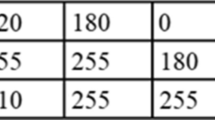Abstract
In this paper, a new filter, η–LM, which is based on Levenberg-Marquardt Artificial Neural Networks, is proposed for the impulsive noise suppression from highly distorted images. The η–LM uses Anderson-Darling goodness-of-fit test in order to find corrupted pixels more accurately. The extensive simulation results show that the proposed filter achieves a superior performance to the other filters mentioned in this paper in the cases of being effective in detail preservation and noise suppression, especially when the noise density is very high.
Preview
Unable to display preview. Download preview PDF.
Similar content being viewed by others
References
Çiviciog̃lu, P., Alçı, M.: Impulsive Noise Ssuppression from Highly Distorted Images with Triangular Interpolants. AEU International Journal of Electronics and Communications 58, 311–318 (2004)
Çiviciog̃lu, P., Alçı, M.: Edge Detection of Highly Distorted Images Suffering from Impulsive Noise. AEU International Journal of Electronics and Communications 58, 413–419 (2004)
Çiviciog̃lu, P., Alçı, M., Beşdok, E.: Using an Exact Radial Basis Function Artificial Neural Network for Impulsive Noise Ssuppression from Highly Distorted Image Databases. In: Yakhno, T. (ed.) ADVIS 2004. LNCS, vol. 3261, pp. 383–391. Springer, Heidelberg (2004)
Çiviciog̃lu, P., Alçı, M., Beşdok, E.: Impulsive Noise Suppression from Images with the Noise Exclusive Filter. EURASIP Journal on Applied Signal Processing 2004(16), 2434–2440 (2004)
Beşdok, E., Çiviciog̃lu, P., Alçı, M.: Impulsive Noise Suppression from Highly Corrupted Images by Using Resilient Neural Networks. In: Rutkowski, L., Siekmann, J.H., Tadeusiewicz, R., Zadeh, L.A. (eds.) ICAISC 2004. LNCS (LNAI), vol. 3070, pp. 670–675. Springer, Heidelberg (2004)
Yüksel, M.E., Baştürk, A.: Efficient Removal of Impulse Noise from Highly Corrupted Digital Images by a Simple Neuro-fuzzy Operator. AEU International Journal of Electronics and Communications 57, 214–219 (2003)
Wang, J., Liu, W., Lin, L.: Histogram-based Fuzzy Filter for Image Restoration. IEEE Transactions on Systems, Man, and Cybernetics-Part B: Cybernetics 32, 230–238 (2002)
Russo, F., Ramponi, G.: A Fuzzy Filter for Images Corrupted by Impulse Noise. IEEE Signal Processing Letters 3, 168–170 (1996)
Pok, G., Liu, J.C., Nair, A.: Selective Removal of Impulse Noise Based on Homogeneity Level Information. IEEE Transactions on Image Processing 12, 85–92 (2003)
MathWorks: Matlab v.6.2., Reference Guides, New York:The MathWorks, Inc. (2004)
Palisade: Bestfit, Probability Distribution Fitting for Microsoft Windows, Software, Version 4.5.2 (2002)
Brown, C.L., Zoubir, A.M.: Testing for Impulsive Behavior: A Bootstrap Approach. Digital Signal Processing 11, 120–132 (2001)
Hagan, M.T., Menhaj, M.B.: Training Feedforward Networks with the Marquardt Algorithm. IEEE Trans. Neural Networks 5, 989–993 (1994)
Agrell, E., Eriksson, T., Vardy, A., Zeger, K.: Closest Point Search in Lattices. IEEE Transactions On Information Theory 48, 2201–2214 (2002)
Henk, M.: Note on Shortest and Nearest Lattice Vectors. Information Processing Letters 61, 183–188 (1997)
Author information
Authors and Affiliations
Editor information
Editors and Affiliations
Rights and permissions
Copyright information
© 2005 Springer-Verlag Berlin Heidelberg
About this paper
Cite this paper
Çivicioğlu, P. (2005). Using LM Artificial Neural Networks and η-Closest-Pixels for Impulsive Noise Suppression from Highly Corrupted Images. In: Wang, J., Liao, XF., Yi, Z. (eds) Advances in Neural Networks – ISNN 2005. ISNN 2005. Lecture Notes in Computer Science, vol 3497. Springer, Berlin, Heidelberg. https://doi.org/10.1007/11427445_110
Download citation
DOI: https://doi.org/10.1007/11427445_110
Publisher Name: Springer, Berlin, Heidelberg
Print ISBN: 978-3-540-25913-8
Online ISBN: 978-3-540-32067-8
eBook Packages: Computer ScienceComputer Science (R0)




